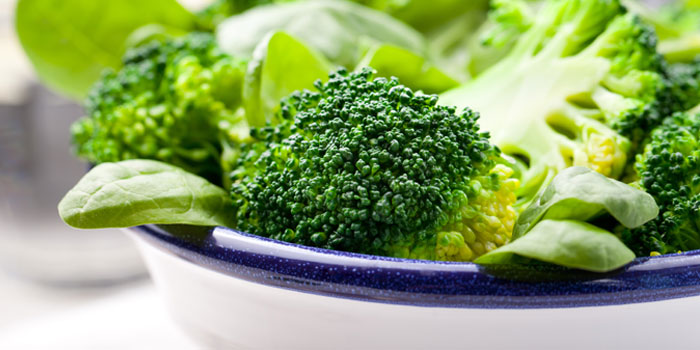St Patrick’s Day – Green is the Colour!

The colour green is associated with many things ranging from the environmental movement, nature, spring, envy, naivety, and of course Ireland, also known as the Emerald Isle. The national day of Ireland, or St Patrick’s day, is celebrated on the 17th March. You’ll know when it comes around because the colour green will be everywhere! This seems like a good opportunity to look at what green means when it comes to food.
It is largely chlorophyll that gives plants their green colour. Chlorophyll is the chemical by which plants photosynthesise sunlight into energy, something that animals cannot do. Luckily we can benefit from the chlorophyll in plants by eating them. Many green vegetables come under the umbrella of the brassica family (AKA cruciferous vegetables) which encompasses broccoli, cabbage, Brussels sprouts, rocket and kale. There is a huge amount of evidence showing the health-promoting properties of these green super foods.
Brassicas have been found to:
- Contain high levels of antioxidants including glucosinolates, isothiocyanates and nitriles (1).
- Protect against some cancers (1, 2).
- Protect against high cholesterol and cardiovascular disease (3).
- Reduce oxidative stress in the liver (3).
- Heal stomach ulcers and inhibit gastric damage (4).
Maximising the Benefits
It’s worth knowing that the concentration and bio-availability of polyphenols, glucosinolates, sulforaphane, vitamin C and selenium in these nutritional power houses can vary depending on how they are cultivated, processed, prepared and cooked (1). Here are some easy tips for optimising the life giving properties of brassicas:
Preparation Methods
- Steaming and drying broccoli results in an increase in availability of the beneficial sulforaphane and antioxidant activity (1).
- Freezing and boiling broccoli both diminish the polyphenol concentration, partly due to leaching into the water. This means that cooking vegetables in a soup or stew where the water is consumed is preferable to cooking the vegetables separately and discarding the water. If you do boil your vegetables keep the cooking water in the fridge to use in soup, stock or gravy.
- Adding mustard seeds to boiled broccoli makes up for some of the losses caused by cooking (5).
- Finely sliced cabbage leaves have greater healing properties than whole leaves (6).
- Mixing shredded cabbage leaves with an oil based dressing results in an even greater release of beneficial compounds (6).
- A combination of different cruciferous vegetables is likely to provide even more benefits than eating them separately (7).
Here are some tips on how to incorporate the brassica family into your meals:
Stir fries – add broccoli florets, shredded cabbage or chopped kale to stir fries.
Coleslaw – add shredded red or green cabbage to grated carrots for a home made coleslaw. Instead of mayonnaise stir in an olive oil and lemon juice dressing with a dash of tamari soy sauce and some toasted seeds.
Stews and Casseroles – can always benefit from the addition of broccoli, cabbage, Brussels sprouts or kale.
Curries – cauliflower and broccoli florets are excellent additions to curries along with root vegetables and pulses such as chickpeas or lentils.
Salads – watercress and rocket can be combined with lettuce and other salad leaves. Sprinkle on a dressing of olive oil and cider vinegar to increase nutrient absorption.
Bubble and Squeak – fry left over cooked cabbage with mashed potato for a deliciously comforting brunch.
References
- 1. Mahn A, Reyes A. n overview of health-promoting compounds of broccoli (Brassica oleracea var. italica) and the effect of processing. Food Sci Tech Int. 2012 Dec;18(6):503-14.
- 2. Proc Nutr Soc. 2009 Feb;68(1):103-10. Conference on “Multidisciplinary approaches to nutritional problems”. Symposium on “Nutrition and health”. Cruciferous vegetable intake and the risk of human cancer: epidemiological evidence. Kim MK, Park JH.
- 3. Sankhari JM, Thounaojam MC, Jadeja RN, Devkar RV, Ramachandran AV. Anthocyanin-rich red cabbage (Brassica oleracea L.) extract attenuates cardiac and hepatic oxidative stress in rats fed an atherogenic diet. J Sci Food Agric. 2012 Jun;92(8):1688-93.
- 4. Carvalho CA, Fernandes KM, Matta SL, Silva MB, Oliveira LL, Fonseca CC. Evaluation of antiulcerogenic activity of aqueous extract of Brassica oleracea var. capitata (cabbage) on Wistar rat gastric ulceration. Arg Gastroenterol. 2011 Oct-Dec;48(4):276-82.
- 5. J Food Sci. 2014 Sep;79(9):S1756-62. Consumer acceptability and sensory profile of cooked broccoli with mustard seeds added to improve chemoprotective properties. Ghawi SK, Shen Y, Niranjan K, Methven L.
- 6. Urikura M, Morishige J, Tanaka T, Satouchi K. Phosphatidic Acid production in the processing of cabbage leaves. J Agric Food Chem. 2012 Nov 14;60(45)
- 7. Int J Vitam Nutr Res. 2003 Mar;73(2):135-43. Non-nutritive bioactive constituents of plants: dietary sources and health benefits of glucosinolates. Lund E.